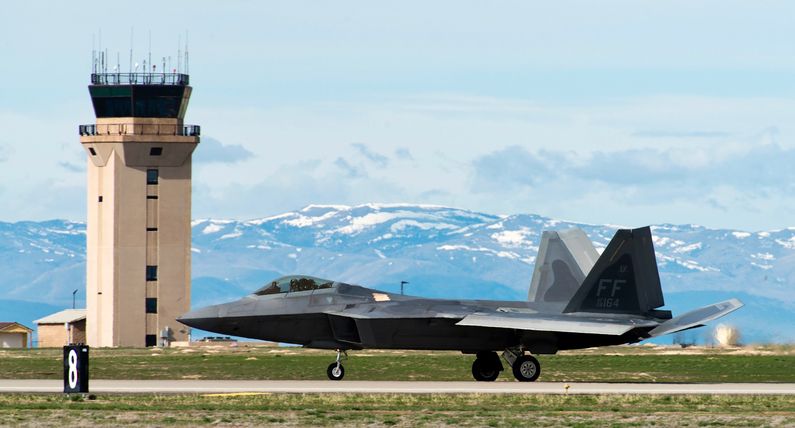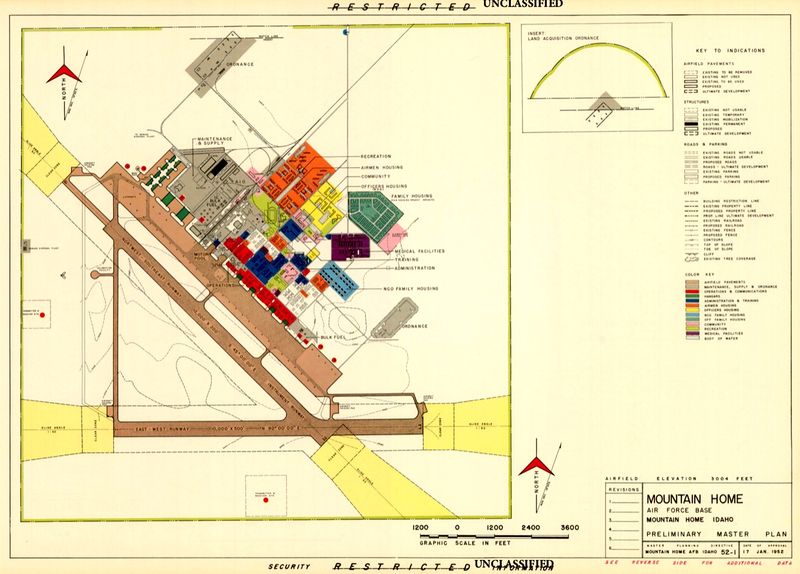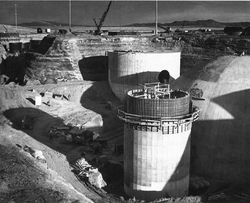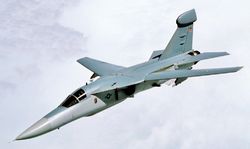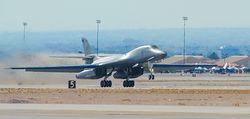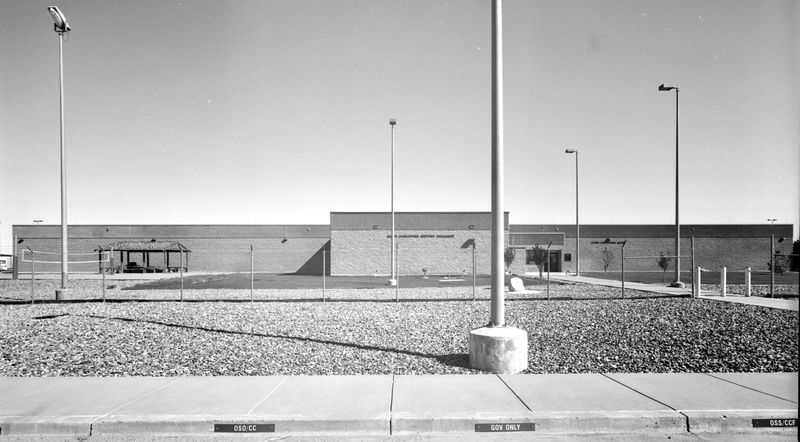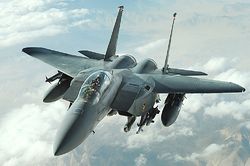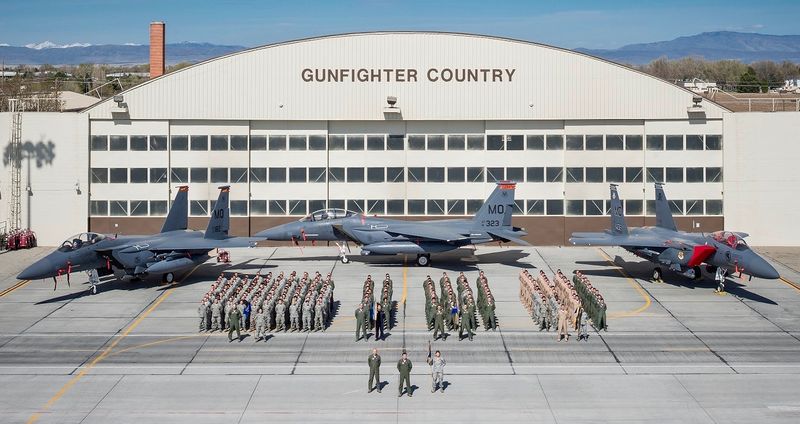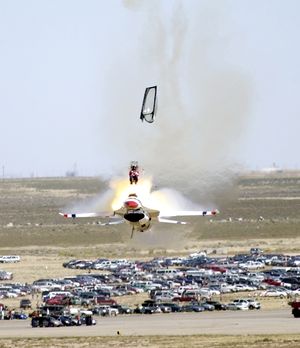Mountain Home Air Force Base
|
Mountain Home Air Force Base (1942-Active) - A United States Air Force Base first established in 1942 as Mountain Home Army Air Base at Mountain Home, Elmore County, Idaho. Also known as Mountain Home Army Air Field. Renamed Mountain Home Air Force Base in 1948. Active Air Force Base.
World War IIConstruction began in November 1942 and the airfield officially opened on 7 Aug 1943. Training began for U.S. Army Air Force crews for the B-24 Liberator bomber. The first group was the 470th Bombardment Group (Heavy), which trained at Mountain Home from May 1943 until January 1944, when that unit moved to Tonopah AAF Nevada. The 490th Bombardment Group (Heavy) replaced the 470th and trained B-24 crews until it deployed to England in April 1944. The 494th Bombardment Group then replaced the 490th, still training Liberator crews. In October 1945 the base was placed in an inactive status. Post World War IIThe base remained inactive for over three years, until December 1948, when the newly created U.S. Air Force reopened the base. The 4205th Air Base Group was activated on 12 Dec 1948 to prepare the newly re-designated Mountain Home Air Force Base for operational use. Cold WarIn 1953, the base was transferred to Strategic Air Command which assigned the 9th Bombardment Wing to Mountain Home in May 1953 and began flying B-29 bombers and KB-29H refueling aircraft. The 9th began converting to the new B-47 Stratojet bomber and the KC-97 tanker in September 1954.
Titan MissilesOn 5 Feb 1960, Colonel Paul H. Symbol of the Walla Walla Corps of Engineers District opened bids for the construction of the three Titan missile sites attached to Mountain Home AFB. Each of the three sites was to have three missile silos and a control module. Of the six bidders, the joint venture of Kaiser-Raymond-Macco-Puget Sound came in with a low winning bid of approximately $28.9 million. Notice to proceed was granted on 9 Feb 1960. Contract oversight was switched in October 1960 from the Walla Walla District to the Titan I Directorate of the Corps of Engineers Ballistic Missile Construction Office (CEBMCO) in Los Angeles as part of a national centralization of missile construction oversight. By 30 May 1962, there were 246 modifications to the construction contract and some of these modifications required expensive reconstruction. The final construction cost exceeded $51 million. The 569th Strategic Missile Squadron was activated on 1 Jun 1961 and the contractor team completed work on the sites before the 1 Apr 1962 deadline. On 16 May 1964, Defense Secretary McNamara directed an accelerated phaseout of Titan I and Atlas ICBMs. As a result, the 569th was deactivated in June 1965.
In late 1965, the U.S. Air Force began phasing out the aging B-47 bomber and announced plans to bring the 67th Tactical Reconnaissance Wing to Mountain Home. The 389th, 390th, and 391st Tactical Fighter Squadrons had returned from South Vietnam, joined the 347th, and began converting to F-111A aircraft. 366th Fighter WingThe 366th Fighter Wing (in various designations) was the host unit at Mountain Home for over 35 years, following its return from the Vietnam War in late 1972. Before the 366th Tactical Fighter Wing's arrival at Mountain Home, the 389th, 390th, and 391st Tactical Fighter Squadrons had returned from South Vietnam, joined the 347th, and began converting to F-111A aircraft. For the first time since it left for Vietnam, the wing once again had its three original flying units. In 1969, Det. 1, 320 BW from Mather Air Force Base began an alert mission at Mountain Home AFB with two B-52 bombers and two KC-135 tankers. The unit disbanded in the spring of 1975 and returned to Mather AFB. Operations continued unchanged for several years. The wing tested its readiness in August 1976 when a border incident in Korea prompted the U.S. to augment its military contingent in South Korea as a show of force. The 366th deployed a squadron of 20 F-111 fighters, which reached Korea only 31 hours after receiving launch notification. Tensions eased shortly afterward and the detachment returned home. In early 1991, the Air Force announced that the 366th would become the Air Force's premier "air intervention" composite wing. The wing would grow with the addition of a squadron of EF-111A Raven electronic warfare aircraft and a squadron of B-1B Lancer bombers to become a dynamic, five squadron wing with the ability to deploy rapidly and deliver integrated combat airpower. The air intervention composite wing's rapid transition from concept to reality began in October 1991 when Air Force redesignated the wing as the 366th Wing. The wing's newly reactivated "fighter squadrons" became part of the composite wing in March 1992. The 389th Fighter Squadron began flying the dual-role F-16C Fighting Falcon, while the 391st Fighter Squadron was equipped with the new F-15E Strike Eagle. These two squadrons provide Gunfighters round-the-clock precision strike capability. Over the Horizon Backscatter Radar (OTH-B) SystemThe FPS-118 OTH-B System was developed in the 1970s and 1980s to provide all-altitude, long-range surveillance of aerial approaches to the United States. OTH-B radar systems use the ionosphere to refract outgoing radar waves and return signals, enabling the system to detect and track targets that would otherwise be hidden by the curvature of the earth, at ranges of up to 1,800 nautical miles. Original design configuration included plans for three OTH-B radar systems in the continental United States (East Coast, West Coast, and Central facing south) and one in Alaska. Each OTH-B system consists of an operations center, a receive site, and a transmit site, all geographically separated to prevent interference. The West Coast OTH-B was headquartered at Mountain Home AFB where computers and communications gear located in a purpose-built operations building sent instructions to a transmitter site near Christmas Valley, OR, and received radar data from a Receiver site near Tulelake, CA, in the Modoc National Forest. The West Coast system was installed but never became operational because of the breakup of the Soviet Union and the end of the Cold War. The West Coast System was officially placed in caretaker status and as it became clear that it was technologically outdated and unsupportable the equipment was removed and the remote sites put up for sale. In 2005 the large OTH-B Operations Center on Mountain Home AFB was turned over to the base for use as office space. By 2009 the base was using the building to house elements of the 366th Operations Group.
Post 9-11 OperationsFollowing the terrorist attacks on 11 Sep 2001, the resultant initiation of Operation ENDURING FREEDOM (OEF), the 366th Wing once again got the call. While the 34th Bomb Squadron deployed to Diego Garcia as the B-1 component of the 28th Air Expeditionary Wing, the wing sent a Base Operations Support package to Al Udeid Air Base, Qatar, to transform the bare base into a fully functional airfield for large-scale combat operations. In October 2001, the 391st Fighter Squadron deployed to Al Jaber Air Base, Kuwait, while the 389th Fighter Squadron went to Al Udeid in November. Following the wing's return from Southwest Asia, the Air Force began consolidating its B-1 Lancer and KC-135 Stratotanker forces. This led to the reallocation of the wing's bombers and tankers. The 22 ARS' aircraft began transferring to McConnell AFB, Kansas, in May 2002 and the squadron inactivated the following August. The 34 BS' B-1Bs began moving to Ellsworth AFB, South Dakota, in June and the squadron officially moved in September. Following the departure of these assets, the Air Force re-designated the 366th as a Fighter Wing. With these changes, the wing's 10-year mission as the Air Force's only standing air expeditionary wing came to an end. A continued reconstruction of the 366 Fighter Wing was official with the 2005 base realignment, coinciding with the large scale integration of the 150+ F-22 Raptors. After the F-16 departure, Mountain Home AFB was chosen to become an F-15E installation because of its ideal training terrain range that is suited for air-to-ground, and air-to-air training missions.
Thunderbirds CrashThe base was the site of a Thunderbirds crash on 14 Sep 2003 in which no one was killed. Captain Chris Stricklin, flying Thunderbird 6, attempted a "Split S" maneuver (which he had performed over 200 times) immediately after takeoff based on an incorrect mean-sea-level elevation. Climbing to only 1,670' above ground level (AGL) instead of 2,500' Stricklin had insufficient altitude to complete the descending half-loop maneuver. He guided the F-16C aircraft down runway 30, away from the spectators and ejected less than one second before impact. His parachute deployed when he was just above the ground and Stricklin survived with only minor injuries. No one on the ground was injured, but the $20 million aircraft was destroyed. Official procedure for demonstration "Split-S" maneuvers was changed and the Thunderbird pilots now climb an extra 1,000' before performing the Split S maneuver.
Current StatusActive Air Force Base. The wing is home to three fighter squadrons: the 389th Fighter Squadron, 391st Fighter Squadron and the Republic of Singapore 428th Fighter Squadron. The wing has the firepower of more than 50 F-15E Strike Eagle aircraft and 12 Republic of Singapore Air Force F-15SG aircraft. The 726th Air Control Squadron detachment assigned here gives an air picture to the aircraft as they train. An active Air National Guard unit, the 266th Range Squadron, controls and maintains emitter sites within the 7,412-square mile operational training range located in southern Idaho.
See Also: Sources:
Links: Visited: 21 Aug 2023
| |||||||||||||||||||||||||||||||||||||||||||||||||||
